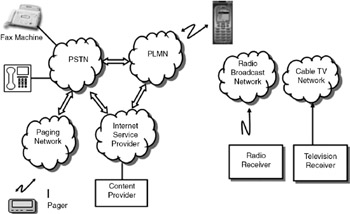Chapter 39: Futuristic Technologies and Applications
|
| < Day Day Up > |
|
In the last decade of the twentieth century, many exciting technologies have become popular. Notable among them are the World Wide Web and wireless Internet access. Commercialization of services using computer telephony integration and multimedia communication over IP networks also happened on a large scale in recent years. In the first decade of the twenty-first century, we will witness more exciting developments. These developments will be catalyzed by the availability of high bandwidth transmission media to our homes and offices as well as the availability of high bandwidth wireless networks. Anywhere, anytime high-speed communication for anybody will be the theme of the first decade of the twenty-first century. In this chapter, we will trace past developments based on which the present architecture of the telecommunication networks evolved. We will also peep into some futuristic technologies and applications.
39.1 EVOLUTION OF THE PRESENT TELECOMMUNICATION NETWORK ARCHITECTURE
Ever since Alexander Graham Bell invented the telephone, there have been tremendous improvements in telecommunication technology. The Pubic Switched Telephone Network (PSTN) initially consisted of mechanical and electromechanical switches and copper cables. These switches are being replaced by digital switches. Today the telephone networks in the developed countries are mostly digital and driven by software power. Though copper cables are still widely used as the transmission medium, trunk routes are now using optical fiber that can support millions of voice calls. Today, making a telephone call to anyone, anywhere on the Earth is child's play!
In the early 1970s, the Internet was developed to provide data services. In a span of about 30 years, the Internet has spread all over the world, connecting millions of computers and providing data services, and communicating has become much easier. Though the Internet was mainly intended for data services, it is now becoming the platform for voice and video services as well.
| Note | Though voice over IP is slowly gaining popularity, voice service over the Internet is not very high quality compared to the PSTN. |
In the 1960s, mobile communication systems were deployed, paving the way for communicating while on the move. The mobile networks of earlier days supported only voice communication, but slowly data services, though at low speeds, became available. In the 1990s, wireless Internet took off, to access Internet content through mobile phones. Multimedia messaging on wireless networks is now in the works.
| Note | Due to the advances in low bit rate coding of voice and video signals coupled, with advances in efficient modulation and multiple access techniques, mobile communication systems can now support data rates up to 50Mbps. |
The broadcasting systems, for radio and TV broadcasting, are the main entertainment systems. TV in particular has brought the entire world to our living rooms. The news of any corner of the world is made known to the entire world almost instantaneously. TV program distribution is done through the cable TV network or through satellites direct to homes.
| Note | Though current TV transmission is mostly analog, digital TV transmission will be predominant in the future. This will give much better quality video, called high-definition TV (HDTV). |
All these developments have taken place at a breath-taking pace, and today the telecommunication systems provide us the means of communicating very effectively. However, as shown in Figure 39.1, today we use different networks for doing different things—we use the Public Switched Telephone Network (PSTN) for making telephone calls and sending fax messages, we use the public land mobile network (PLMN) to make calls from mobile phones, we use the paging network for paging services, we access data services from the Internet through an Internet service provider, the cable TV network (in conjunction with satellite TV network) provides us with TV programs, and the radio broadcasting network provides us the audio programs. We have to use different gadgets to use different networks to get different services. These gadgets include a fixed telephone, a cordless phone at home and office, a fax machine, a mobile phone, a pager, a TV set, a desktop computer, a laptop computer, a palmtop computer. Using so many gadgets is a problem. We also subscribe to different services and pay bills separately—one bill for Internet access, one bill to the fixed telephone, one bill to the mobile phone, and so on. For end users of telecommunication services, all this causes a lot of inconvenience and so on.

Figure 39.1: Architecture of telecommunications networks.
Using multiple networks for different services is very inconvenient for users because we need different devices, we get multiple bills, and need to access different mailboxes.
|
| < Day Day Up > |
|
EAN: 2147483647
Pages: 313
- An Emerging Strategy for E-Business IT Governance
- Linking the IT Balanced Scorecard to the Business Objectives at a Major Canadian Financial Group
- Measuring and Managing E-Business Initiatives Through the Balanced Scorecard
- The Evolution of IT Governance at NB Power
- Governance Structures for IT in the Health Care Industry